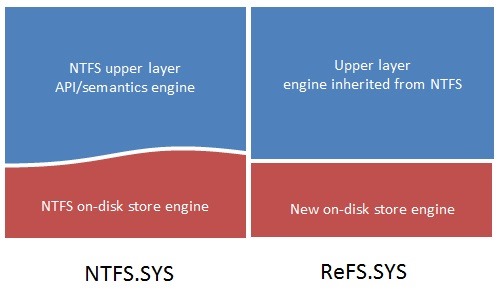Microsoft will replace NTFS with ReFS in Windows Server 8

Windows server 8 will introduce the Resilient File System, or ReFS, as a “next generation file system” built on the foundations of the NTFS. The new gen file system is designed by reusing NTFS’ API / semantics engine to retain a high level of compatibility with NTFS features. The new file system design is aimed to protect against latent disk errors, resist data corruption, uphold metadata integrity, grant large volume, file and directory size. The whole concept is to reduce the massive file corruption and fragmentation users face with NTFS and Windows in general.
The key goals of ReFS are:
- Maintain a high degree of compatibility with a subset of NTFS features that are widely adopted while deprecating others that provide limited value at the cost of system complexity and footprint.
- Verify and auto-correct data. Data can get corrupted due to a number of reasons and therefore must be verified and, when possible, corrected automatically. Metadata must not be written in place to avoid the possibility of “torn writes,” which we will talk about in more detail below.
- Optimize for extreme scale. Use scalable structures for everything. Don’t assume that disk-checking algorithms, in particular, can scale to the size of the entire file system.
- Never take the file system offline. Assume that in the event of corruptions, it is advantageous to isolate the fault while allowing access to the rest of the volume. This is done while salvaging the maximum amount of data possible, all done live.
- Provide a full end-to-end resiliency architecture when used in conjunction with the Storage Spaces feature, which was co-designed and built in conjunction with ReFS.
The key features of ReFS are as follows (note that some of these features are provided in conjunction with Storage Spaces).
- Metadata integrity with checksums
- Integrity streams providing optional user data integrity
- Allocate on write transactional model for robust disk updates (also known as copy on write)
- Large volume, file and directory sizes
- Storage pooling and virtualization makes file system creation and management easy
- Data striping for performance (bandwidth can be managed) and redundancy for fault tolerance
- Disk scrubbing for protection against latent disk errors
- Resiliency to corruptions with “salvage” for maximum volume availability in all cases
- Shared storage pools across machines for additional failure tolerance and load balancing
What are the capacity limits of ReFS?
The table below shows the capacity limits of the on-disk format. Other concerns may determine some practical limits, such as the system configuration (for example, the amount of memory), limits set by various system components, as well as time taken to populate data sets, backup times, etc.
|
Attribute |
Limit based on the on-disk format |
|
Maximum size of a single file |
2^64-1 bytes |
|
Maximum size of a single volume |
Format supports 2^78 bytes with 16KB cluster size (2^64 * 16 * 2^10). Windows stack addressing allows 2^64 bytes |
|
Maximum number of files in a directory |
2^64 |
|
Maximum number of directories in a volume |
2^64 |
|
Maximum file name length |
32K unicode characters |
|
Maximum path length |
32K |
|
Maximum size of any storage pool |
4 PB |
|
Maximum number of storage pools in a system |
No limit |
|
Maximum number of spaces in a storage pool |
No limit |
























